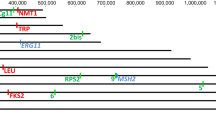Abstract
This study aimed to elucidate the genetic relatedness and epidemiology of 127 clinical and environmental Candida glabrata isolates from Europe and Africa using multilocus microsatellite analysis. Each isolate was first identified using phenotypic and molecular methods and subsequently, six unlinked microsatellite loci were analyzed using automated fluorescent genotyping. Genetic relationships were estimated using the minimum-spanning tree (MStree) method. Microsatellite analyses revealed the existence of 47 different genotypes. The fungal population showed an irregular distribution owing to the over-representation of genetically different infectious haplotypes. The most common genotype was MG-9, which was frequently found in both European and African isolates. In conclusion, the data reported here emphasize the role of specific C. glabrata genotypes in human infections for at least some decades and highlight the widespread distribution of some isolates, which seem to be more able to cause disease than others.

Similar content being viewed by others
References
Bolotin-Fukuhara M, Fairhead C (2014) Candida glabrata: a deadly companion? Yeast 31:279–288. doi:10.1002/yea.3019
Pfaller MA, Andes DR, Diekema DJ, Horn DL, Reboli AC, Rotstein C, Franks B, Azie NE (2014) Epidemiology and outcomes of invasive candidiasis due to non-albicans species of Candida in 2,496 patients: data from the Prospective Antifungal Therapy (PATH) registry 2004–2008. PLoS One 9, e101510. doi:10.1371/journal.pone.0101510
Quindós G (2014) Epidemiology of candidaemia and invasive candidiasis. A changing face. Rev Iberoam Micol 31:42–48. doi:10.1016/j.riam.2013.10.001
Silva S, Negri M, Henriques M, Oliveira R, Williams DW, Azeredo J (2012) Candida glabrata, Candida parapsilosis and Candida tropicalis: biology, epidemiology, pathogenicity and antifungal resistance. FEMS Microbiol Rev 36:288–305. doi:10.1111/j.1574-6976.2011.00278.x
Li L, Redding S, Dongari-Bagtzoglou A (2007) Candida glabrata: an emerging oral opportunistic pathogen. J Dent Res 86:204–215. doi:10.1177/154405910708600304
Tomczak H, Szałek E, Grześkowiak E (2014) The problems of urinary tract infections with Candida spp. aetiology in women. Postepy Hig Med Dosw (Online) 68:1036–1039. doi:10.5604/17322693.1118989
Sardi JC, Scorzoni L, Bernardi T, Fusco-Almeida AM, Mendes Giannini MJ (2013) Candida species: current epidemiology, pathogenicity, biofilm formation, natural antifungal products and new therapeutic options. J Med Microbiol 62:10–24. doi:10.1099/jmm.0.045054-0
Pfaller MA, Castanheira M, Messer SA, Moet GJ, Jones RN (2010) Variation in Candida spp. distribution and antifungal resistance rates among bloodstream infection isolates by patient age: report from the SENTRY Antimicrobial Surveillance Program (2008–2009). Diagn Microbiol Infect Dis 68:278–283. doi:10.1016/j.diagmicrobio.2010.06.015
Turner SA, Butler G (2014) The Candida pathogenic species complex. Cold Spring Harb Perspect Med 4:a019778. doi:10.1101/cshperspect.a019778
Chapeland-Leclerc F, Hennequin C, Papon N, Noël T, Girard A, Socié G, Ribaud P, Lacroix C (2010) Acquisition of flucytosine, azole, and caspofungin resistance in Candida glabrata bloodstream isolates serially obtained from a hematopoietic stem cell transplant recipient. Antimicrob Agents Chemother 54:1360–1362. doi:10.1128/AAC.01138-09
Abbes S, Sellami H, Sellami A, Hadrich I, Amouri I, Mahfoudh N, Neji S, Makni F, Makni H, Ayadi A (2012) Candida glabrata strain relatedness by new microsatellite markers. Eur J Clin Microbiol Infect Dis 31:83–91. doi:10.1007/s10096-011-1280-4
Amouri I, Sellami H, Abbes S, Hadrich I, Mahfoudh N, Makni H, Ayadi A (2012) Microsatellite analysis of Candida isolates from recurrent vulvovaginal candidiasis. J Med Microbiol 61:1091–1096. doi:10.1099/jmm.0.043992-0
Brisse S, Pannier C, Angoulvant A, de Meeus T, Diancourt L, Faure O, Muller H, Peman J, Viviani MA, Grillot R, Dujon B, Fairhead C, Hennequin C (2009) Uneven distribution of mating types among genotypes of Candida glabrata isolates from clinical samples. Eukaryot Cell 8:287–295. doi:10.1128/EC.00215-08
Foulet F, Nicolas N, Eloy O, Botterel F, Gantier JC, Costa JM, Bretagne S (2005) Microsatellite marker analysis as a typing system for Candida glabrata. J Clin Microbiol 43:4574–4579. doi:10.1128/JCM.43.9.4574-4579.2005
Criseo G, Scordino F, Romeo O (2015) Current methods for identifying clinically important cryptic Candida species. J Microbiol Methods 111:50–56. doi:10.1016/j.mimet.2015.02.004
Romeo O, Scordino F, Pernice I, Lo Passo C, Criseo G (2009) A multiplex PCR protocol for rapid identification of Candida glabrata and its phylogenetically related species Candida nivariensis and Candida bracarensis. J Microbiol Methods 79:117–120. doi:10.1016/j.mimet.2009.07.016
Guichoux E, Lagache L, Wagner S, Chaumeil P, Léger P, Lepais O, Lepoittevin C, Malausa T, Revardel E, Salin F, Petit RJ (2011) Current trends in microsatellite genotyping. Mol Ecol Resour 11:591–611. doi:10.1111/j.1755-0998.2011.03014.x
Hunter PR, Gaston MA (1998) Numerical index of the discriminatory ability of typing systems: an application of Simpson’s index of diversity. J Clin Microbiol 26:2465–2466
Esposto MC, Prigitano A, Romeo O, Criseo G, Trovato L, Tullio V, Fadda ME, Tortorano AM; FIMUA Working Group (2013) Looking for Candida nivariensis and C. bracarensis among a large Italian collection of C. glabrata isolates: results of the FIMUA working group. Mycoses 56:394–396. doi:10.1111/myc.12026
Van Belkum A, Tassios PT, Dijkshoorn L, Haeggman S, Cookson B, Fry NK, Fussing V, Green J, Feil E, Gerner-Smidt P, Brisse S, Struelens M (2007) Guidelines for the validation and application of typing methods for use in bacterial epidemiology. Clin Microbiol Infect 13:1–46. doi:10.1111/j.1469-0691.2007.01786.x
Author information
Authors and Affiliations
Corresponding author
Ethics declarations
Funding
This research was supported in part by the EU Mare Nostrum (EUMN-III Call) program of the European Union, grant agreement number 2011-4050/001-EMA2. Dr Sanae Rharmitt was the recipient of a scholarship (10 months) signed within the EUMN program for PhD students (F.S. 1.04.11.01 UORI) under the supervision of Prof Orazio Romeo.
Conflicts of interest
The authors declare that they have no conflicts of interest.
Ethical approval
This article does not contain any studies with human participants or animals performed by any of the authors.
Informed consent
For this type of study formal consent is not required.
Rights and permissions
About this article
Cite this article
Chillemi, V., Lo Passo, C., van Diepeningen, A.D. et al. Multilocus microsatellite analysis of European and African Candida glabrata isolates. Eur J Clin Microbiol Infect Dis 35, 885–892 (2016). https://doi.org/10.1007/s10096-016-2610-3
Received:
Accepted:
Published:
Issue Date:
DOI: https://doi.org/10.1007/s10096-016-2610-3




